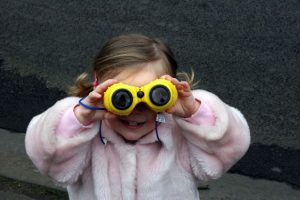The solar spacecraft Juno intersected with the planet Jupiter. This exciting news has inspired the play-of-the-day: sky watching for kids, both big and little. Binoculars can add to the fun, but aren’t necessary.

During the summer isn’t the best time to see stars and space, unless you live in the southern half of the world instead of the northern. For those way up north, at this time of year there is no night, but there’s still lots to see in the day. Before going outside, ask your child what you might see in the sky. This is sort of like preheating the oven. It starts kids thinking about their past experiences and collecting the bits they already know about skies. You can tease your child with silly suggestions such as, “I think I’ll see a car in the sky.” Of course, kids know cars are on the road so they may giggle or gleefully correct you. Maybe there will be a flying boat?
Once outside, check out what is in the sky. Are there any clouds today? Is the sky sunny or rainy? Any birds, kites, or airplanes? The stars or moon? Where do they go in the daytime? Kids ask about 300 questions a day so be prepared and ask some of your own
Some kids may have been up late already watching fireworks at night, but if they don’t have to go to bed early, take some time and check out the sky at night. It looks very different. The weather may be warm enough that kids can take a towel or blanket and pillow to the backyard or deck and watch for shooting stars outside. There could be other objects and lights moving in the night sky. Kids might be able to see pictures and shapes in the stars.

Out of all the things in the sky, isn’t it amazing that a spacecraft from Earth could even find Jupiter, let alone land? Great achievement NASA. What better way to celebrate than by sky watching for kids and marveling?
